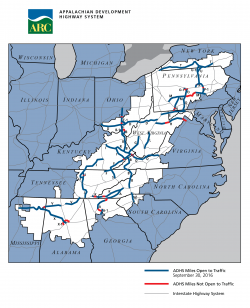Today, the Appalachian Regional Commission (ARC) released a new study about the Appalachian Development Highway System (ADHS), a network of 32 distinct highway corridors totaling 3,090 miles and connecting the 13 Appalachian states with other interstate highways. The study, Economic Analysis of Completing the Appalachian Development Highway System, estimates the economic outcomes of ADHS work completed to date and forecasts the future economic impacts, benefits, and costs associated with completing the system.

“This study shows that the Appalachian Development Highway System continues to be the backbone for economic development across the Region,” said ARC Federal Co-Chair Earl F. Gohl. “Each mile of the ADHS opens new opportunities across Appalachia.”
The study’s key findings include:
- Increased economic activity associated with the ADHS system has helped create or support over 168,000 jobs across the 13 Appalachian states, with nearly $7.3 billion of added worker income annually.
- ADHS investments made between 1965 and 2015 generated over $19.6 billion per year of added business sales in Appalachia, representing over $9 billion of added gross regional product.
- The ADHS saves 231 million hours of travel time annually. Twenty percent of car vehicle hours saved and 31 percent of freight truck vehicle hours saved are associated with trips with at least one end located outside the Appalachian states.
- As of 2015, the value of transportation cost savings and productivity gains associated with the ADHS amounts to $10.7 billion annually.
At the end of FY 2016, a total of 2,794.7 miles, or 90.4 percent of the ADHS system, were either complete, open to traffic, or under construction. Completion of the ADHS is estimated to create nearly 47,000 more jobs and facilitate the production and selling of $8.7 billion more in goods and services annually across the 13 Appalachian states.
The ADHS was first authorized by Congress in 1965 with the purpose of stimulating economic development by reducing isolation and improving access for Appalachia, which had been largely left unserved by the interstate highway system. Federal funding for ADHS construction is currently administered by state departments of transportation (DOTs). The Appalachian Regional Commission works directly with the Federal Highway Administration and the state DOTs to monitor ADHS-related activity. Economic Analysis of Completing the Appalachian Development Highway System was prepared by the Economic Development Research Group in association with WSP/Parsons Brinckerhoff for the Appalachian Regional Commission, and managed by Hodge Economic Consulting.
About the Appalachian Regional Commission
The Appalachian Regional Commission is an economic development agency of the federal government and 13 state governments focusing on 420 counties across the Appalachian Region. ARC’s mission is to innovate, partner, and invest to build community capacity and strengthen economic growth in Appalachia to help the Region achieve socioeconomic parity with the nation.